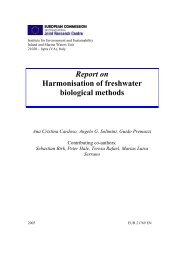Lakes and Watercourses
Lakes and Watercourses
Lakes and Watercourses
Create successful ePaper yourself
Turn your PDF publications into a flip-book with our unique Google optimized e-Paper software.
very high degree of reliability <strong>and</strong> at a much lower cost than previously.<br />
Analyses of metals in aquatic moss (Fontinalis antipyretica <strong>and</strong> F. dalecarlia)<br />
can be used as an indirect measure of concentrations in water. Moss<br />
growing locally as well as planted specimens can be used. Concentrations<br />
in aquatic moss reflect metal concentrations in water over a lengthy<br />
period (weeks) <strong>and</strong> are an effective means of surveying sources <strong>and</strong> the<br />
size of contaminated areas <strong>and</strong> can also be used to gain an idea of the<br />
level of pollution in the aquatic area. However, absorption of metals by<br />
aquatic moss is not dependent merely on the concentration in water;<br />
acidity, for example is another factor. This limits the utility of the<br />
method, particularly in acidified waters.<br />
Concentrations of metals in sediment provide a good picture of the<br />
influx of metals into an aquatic area. Sampling procedures <strong>and</strong> analyses<br />
are fairly simple <strong>and</strong> reliable <strong>and</strong> analyses of sediment are therefore<br />
highly suitable for surveying the impact of metals, for example. By<br />
analysing deeper sediment strata it is possible to extrapolate the time<br />
trend for load backwards in time <strong>and</strong> to determine original metal concentrations<br />
in the aquatic area.<br />
Concentrations of mercury in fish mainly serve to provide a basis for<br />
assessing the risks to humans of eating fish. Metal concentrations in fish<br />
are also a useful means of evaluating the risk of damage to mammals <strong>and</strong><br />
birds whose diet mainly consists of fish.<br />
Assessment of current conditions<br />
TABLE 18.<br />
CURRENT CONDITIONS: metals in water (µg/l)<br />
Class Description Cu 1) Zn Cd Pb Cr Ni As<br />
1 Very low conc. ≤ 0.5 ≤ 5 ≤ 0.01 ≤ 0.2 ≤ 0.3 ≤ 0.7 ≤ 0.4<br />
2 Low conc. 0.5 – 3 5 – 20 0.01 – 0.1 0.2 – 1 0.3 – 5 0.7 – 15 0.4 – 5<br />
3 Mod. high conc. 3 – 9 20 – 60 0.1 – 0.3 1 – 3 5 – 15 15 – 45 5 – 15<br />
4 High conc. 9 – 45 60 – 300 0.3 – 1.5 3 – 15 15 – 75 45 – 225 15 – 75<br />
5 Very high conc. >45 >300 >1.5 >15 >75 >225 >75<br />
1) These values apply particularly to lakes <strong>and</strong> streams. Background concentrations are often higher in<br />
larger watercourses; concentrations of up to 3 µg/l are not uncommon. The boundary between class<br />
1 <strong>and</strong> 2 has been set on the basis of the 75th percentile for northern Swedish streams <strong>and</strong> lakes.<br />
The following may be said of the risk of biological effects caused by<br />
metals in concentrations corresponding to the various classes:<br />
42















![Accommodation booking form [PDF]](https://img.yumpu.com/39471785/1/184x260/accommodation-booking-form-pdf.jpg?quality=85)

